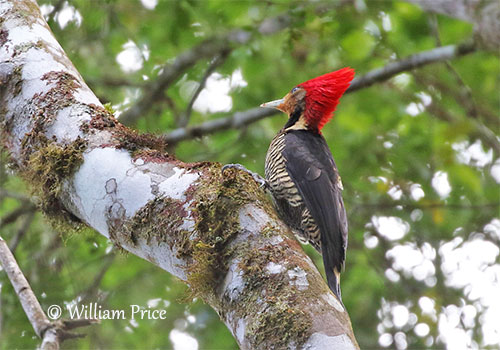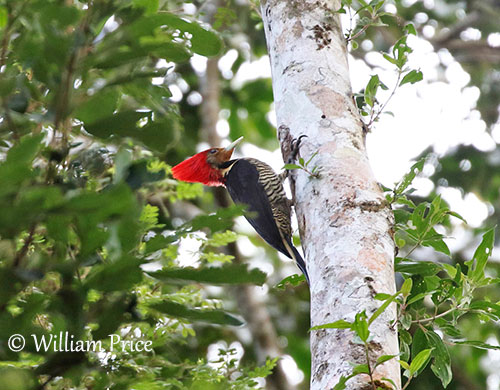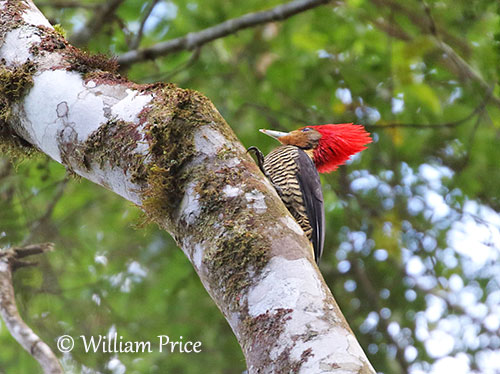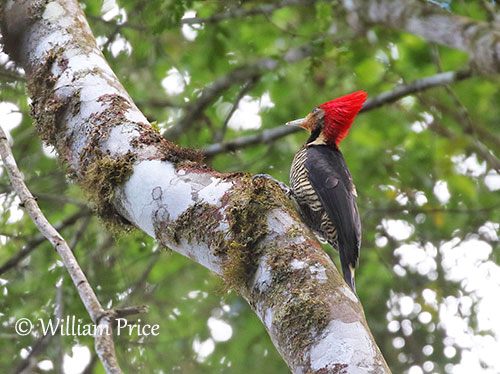
A nest was found in an irregularly-shaped cavity in the dead part of a tree. The cavity was occupied and a nestling was inside, with the head out of the hole. The chick was fed by an adult female Helmeted Woodpecker. It was fed at the nest entrance by regurgitation or from a food crop, not with food held in the adult’s bill. No adult spent the night in the nest.
The young bird fledged on the next morning, without an adult noticeably present. The juvenile jumped from the cavity and made a flight of about 25 metres. The wingbeats were audible and irregular. The young bird was 150 metres from the nesting tree one hour later, after perching at least six times on trees. It was calling continuously “kwee-kwee-kwee”.
The nest was in a forest patch, on a broad flat ridge top, at 630 metres of elevation.
The cavity was 9,50 metres above the ground in a dead branch of a laurel tree. The bark was missing above and below the hole. The entrance was hidden by the foliage of a nearby tree. The cavity was 27 centimetres deep and 24,5 centimetres depth, and the entrance measured 7,5 centimetres tall by 7 centimetres wide. The Helmeted Woodpecker often nests in trees of genus Nectandra.
PROTECTION / THREATS / STATUS:
The Helmeted Woodpecker is threatened by habitat loss through deforestation causing habitat fragmentation. Logging has a strong negative impact on the species.
The release of cattle into forests during winter involves habitat degradation. Construction of dams leads to the flooding and destroys the remaining fragments. Urbanisation, road construction and agriculture in some areas involve the clearing of the forest.
The Helmeted Woodpecker is rare or very uncommon at all known sites. The species is present in small, isolated patches, each of which contains no more than 1,000 mature individuals.
The population is estimated to number less than 10,000 mature individuals. It is continuously declining, and the Helmeted Woodpecker is currently listed as Vulnerable.
Fr: Pic casqué
Ang: Helmeted Woodpecker
All: Wellenohrspecht
Esp: Picamaderos Caricanelo
Ita: Picchio crestato
Nd: Helmspecht
Sd: hjälmkastanjespett
Photographer:
William Price
PBase-tereksandpiper & Flickr William Price
Text by Nicole Bouglouan
Sources:
HANDBOOK OF THE BIRDS OF THE WORLD Vol. 7 by Josep del Hoyo-Andrew Elliott-Jordi Sargatal – Lynx Edicions – ISBN: 8487334377
WOODPECKERS, an identification guide of the woodpeckers of the world by Winkler Hans and Christie David – Helm – ISBN: 0395720435
Woodpeckers of the World: The Complete Guide De Gerard Gorman – Editeur: A&C Black, 2014 – ISBN: 1408147173, 9781408147177 – 448 pages
Endangered Wildlife and Plants of the World, Volume 12 De Marshall Cavendish Corporation – Editeur: Marshall Cavendish, 2001 – ISBN: 0761472061, 9780761472063 – 1872 pages
Helmeted Woodpecker Dryocopus galeatus: a little-known Atlantic Forest endemic
A First For The Atlantic Forest: Radio-Tracking The Helmeted Woodpecker
Avian Hybrids - Why do Robust Woodpecker, Lineated Woodpecker and Helmeted Woodpecker look alike?
A Woodpecker Disguised as . . . Another Woodpecker?
SORA - NEST AND FLEDGLING OF THE HELMETED WOODPECKER
Helmeted Woodpeckers Roost Exclusively in Decay-Formed Tree Cavities
Neotropical Crested Woodpeckers Genus Celeus
Wikipedia, the free encyclopaedia
Helmeted Woodpecker
Celeus galeatus
Piciformes Order – Picidae Family
INTRODUCTION:
The Helmeted Woodpecker is one of the rarest woodpeckers in the Neotropics. It is found from far NE Argentina, SE Brazil and E Paraguay, a large area in which it is threatened by habitat loss, involving an important reduction of the global population.
The Helmeted Woodpecker frequents large tracts of humid, lowland and montane mature forest, and more generally, wooded areas. It typically feeds on various invertebrates by foraging at mid-levels in trees, probing and striping away bark.
Like the members of the family Picidae, it nests in tree cavities, often in dead trees or dead branches in trees, facing an open area such as clearing or trail.
The name of this species, especially the word “helmeted”, refers to the beautiful, bright red, rounded crest of this woodpecker.
It is very similar to the Lineated Woodpecker and the Robust Woodpecker with which it shares the Brazilian forests. But following observations and genetic analysis, it was assumed that the Helmeted Woodpecker is a different species. Its resemblance to these two woodpeckers gives rise to specific behaviours, especially when the bird is foraging in trees.
The Helmeted Woodpecker is heavily threatened by deforestation and habitat fragmentation for agriculture and urbanisation expansion. The species is currently listed as Vulnerable.

All the pictures show a female.
The male has red malar area.
DESCRIPTION OF THE BIRD:
Biometrics:
Length: 27-30 cm
Weight: 124-150 g
The Helmeted Woodpecker was formerly included in the genus Dryocopus, but following genetic analysis, it is now in the genus Celius.
In the adult male, the upperparts including mantle, upperwing and tail are black. On the upperwing, the flight-feathers have cinnamon bases. The tail is mainly black with creamy-white uppertail-coverts extending over half of the rectrices. Lower back and rump are white, the latter with sometimes a few dark bars.
On the underparts, lower throat and upper breast are black with cinnamon spots. Belly to vent is buffy-white with black barring (bars are widest on breast). The underwing is dusky brown with a pale cinnamon patch on coverts and inner wings. There are some sparse black bars on the coverts.
On the male’s head, face and throat are cinnamon, finely marked dark. Lores and throat are tinged rusty. The ear-coverts are finely barred cinnamon and black. We can see a white line extending from neck to upper flank.
The male has red malar area.
The bushy red crown and crest are often helmet-shaped, but the shape may change, depending on posture or mood, being sometimes a well-raised cone when the bird is excited.
The ivory-coloured bill has grey to blue-grey base. It is curved along the culmen and narrow at base. The eyes are brown. Legs and feet are dark grey.
The female (displayed on this page) has similar plumage, but she has smaller bill than male, and slightly longer wings and tail. She lacks the red malar area but face and chin are uniformly cinnamon.
The juvenile is browner and less rufous. It has less black on body and less red on crown. The ear-coverts are grey and more extensively barred.
RANGE:
The Helmeted Woodpecker is found from far NE Argentina, SE Brazil and E Paraguay in the Southern Atlantic Forest of South America.

HABITAT:
The Helmeted Woodpecker occurs at elevations from sea-level up to 1,000 metres.
It frequents lowlands and montane areas where it occurs in forests, from semi-deciduous to mixed deciduous-coniferous forests. It is usually present in large tracks of well-preserved forests, but it also frequents older gallery forest, mixed hardwood stands and forests with Arancaria tree species or emergent Parana pines.
It can be seen occasionally in wooded savanna and fragmented disturbed forest (logged or burnt forest).
CALLS AND SONGS: SOUNDS BY XENO-CANTO
The Helmeted Woodpecker is usually silent outside breeding season.
The most common call is a loud, rising series of 2-6 notes ‘keer-keer-keer-keer-keer-keer” probably used in territorial behaviour. These far-carrying notes are harsh and strident, but they can also be delivered as a slower, pleasant whistling.
The contact call between mates is a mournful “tu-hu-u-u-u-u-u-u” but we can also hear a variant “kee-doo-doo-doo-doo-doo”. Other more intimate calls are described as “che-che-che”. Some “chic” notes are given in alarm.
Drumming: drums are fairly soft with uniform pattern and rather short duration.
BEHAVIOUR IN THE WILD:
The Helmeted Woodpecker feeds on various invertebrates, and especially beetle larvae.
It usually forages alone or in pairs, 14-15 metres above the ground in the forest interior, whereas at forest edge, it forages lower down to 2,50 metres.
It searches for prey on large branches, sometimes covered with mosses and lichens. To reach prey, it removes the bark while pecking, probing under bark, or gleaning. It can be seen taking small white larvae from decayed wood.
Some observations describe the bird foraging on a nest of Crematogaster ants in dead bamboos, and a female eating berries (Alchornea sidifolia) of family Euphorbiaceae.

The Helmeted Woodpecker is very similar to the Lineated Woodpecker and the Robust Woodpecker which are much more aggressive. For this reason, it mimics the plumage of these larger woodpeckers to avoid harassment. The three species share some areas in the Brazilian Forest.
This behaviour is called ISDM or Interspecific Social Dominance Mimicry. This is a newly discovered form of imitation, also used by other bird species.
Thanks to this behaviour, the Helmeted Woodpecker is left alone to feast on its favourite trees and avoids competition for food with the two other larger species.
Like most Picidae species, the Helmeted Woodpecker nests in tree cavities in trunks of dead or partly dead Nectandra lanceolate tree species.
Several woodpeckers may roost in decay-formed cavities in large, old trees. The roosts are in cavities formed by natural decay in large, often living trees. These cavities are not excavated by the birds.
Competition for nest-sites with larger woodpeckers is considered a threat.
The Helmeted Woodpecker is resident.
The flight is probably undulating, as usual in Picidae species, with several wingbeats interspersed with glides.
The wingbeats are noticeably audible during the flight, and probably more during territorial behaviour.
REPRODUCTION OF THIS SPECIES:
The breeding season takes place from September to February.
The reproductive biology of the Helmeted Woodpecker is poorly known.
The nest is described from observations in Cruce Caballero National Park in CE Misiones Province, NE Argentina, in November 2011.
